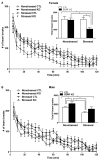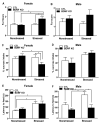Gender-specific impact of brain-derived neurotrophic factor signaling on stress-induced depression-like behavior
- PMID: 19358977
- PMCID: PMC2734472
- DOI: 10.1016/j.biopsych.2009.02.007
Gender-specific impact of brain-derived neurotrophic factor signaling on stress-induced depression-like behavior
Abstract
Background: Major depressive disorder is a leading debilitating disease known to occur at a two-fold higher rate in women than in men. The neurotrophic hypothesis of depression suggests that loss of brain-derived neurotrophic factor (BDNF) may increase susceptibility for depression-like behavior, although direct evidence is lacking.
Methods: Using the chronic unpredictable stress (CUS) paradigm, we investigated whether male and female mice with inducible BDNF deletion in the forebrain were more susceptible to depression-related behavior.
Results: We demonstrate that in certain behavioral measures the loss of BDNF lowers the threshold for female mice studied at random throughout estrus to display anxiogenic and anhedonic behaviors after chronic stress compared with wild-type female mice. However, the loss of BDNF in forebrain does not increase the susceptibility to depression-like behavior in male mice.
Conclusions: These gender differences suggest a role for BDNF in mediating some aspects of depression-related behavior in females.
Figures




References
-
- Diagnostic and Statistical Manual IV. Washington D.C: American Psychiatric Press; 2000.
-
- Kessler RC, Berglund P, Demler O, Jin R, Koretz D, Merikangas KR, et al. The epidemiology of major depressive disorder: results from the National Comorbidity Survey Replication (NCS-R) JAMA. 2003;289:3095–3105. - PubMed
-
- Desai HD, Jann MW. Major depression in women: a review of the literature. J Am Pharm Assoc (Wash) 2000;40:525–537. - PubMed
-
- Duman RS, Monteggia LM. A neurotrophic model for stress-related mood disorders. Biol Psychiatry. 2006;59:1116–1127. - PubMed
-
- Castren E, Voikar V, Rantamaki T. Role of neurotrophic factors in depression. Curr Opin Pharmacol. 2007;7:18–21. - PubMed
Publication types
MeSH terms
Substances
Grants and funding
LinkOut - more resources
Full Text Sources
Other Literature Sources
Medical
Molecular Biology Databases

